
Many of those in the “nature aquarium” movement will find crossover into paludarium keeping to be a fitting and fulfilling juxtaposition. Photo by Erich Sia.
The aquarium hobby/industry has been enjoying an ongoing surge of technological and methodological advancements, as well as an ever-growing selection of aquarium livestock. This can be seen as both a cause and an effect of increasingly sophisticated means of aquatic plant and animal husbandry and display. Those aquarists who have glanced across the aisle might have noted similar developments taking place within the terrarium hobby/industry; indeed, the supply and demand for “herps,” terrarium plants, and exotic arthropods has grown considerably over the last decade. This parallel trend is hardly surprising, as
- many hobbyists (already armed with at least a general knowledge of-and interest in-small animal keeping) regularly straddle the two arts,
- many retail vendors customarily offer both aquarium and terrarium livestock/supplies, and
- many manufacturers develop product lines for both markets.

Successful long-term operation of paludaria like this Shedd Aquarium exhibit require as much patience and planning as they do skill and creativity. Photo by Kenneth Wingerter.
In light of all of this, it is reasonable to foresee a correspondingly growing interest in paludarium keeping. Thus, hobbyists, retailers, and manufacturers alike might benefit from a better familiarity with these potentially intricate systems as well as the flora and fauna potentially maintained therein.
This article focuses on equipping and running paludaria; a forthcoming article will conclude this discussion with a focus on aquascaping, terrascaping, and stocking paludaria.

The needs of highly specialized creatures, such as terrestrial and semi-aquatic crabs, must be addressed from the first steps of paludarium construction. Photo by Kenneth Wingerter.
Enclosures
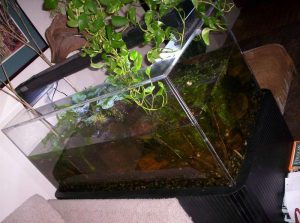
While allowing hanging plants to take root in an uncovered paludarium might have practical or aesthetic advantages, it clearly prohibits the keeping of climbing fauna. Photo by Kenneth Wingerter.
Certain characteristics of the enclosure itself will strongly influence the function and appearance of the paludarium throughout its entire development.
The ideal size of a paludarium is, predictably, the largest that its keeper can afford in time and money to properly maintain. This is fairly reasonable considering that a 55-gallon setup might contain as little as 20-gallons of water, or only a square foot of dry land surface. The paludarist should use estimates of usable space (rather than the total enclosure volume) when assessing potential bioloads, allotting territory for prospective specimens, etc.
The ideal enclosure shape will vary, being a reflection of the needs of the creatures to be kept; enclosures housing crawling creatures will tend towards length, while those housing climbing creatures will tend towards height.
The enclosure can be fabricated out of a number of materials. Glass-fronted enclosures can (with rather exceptional carpentry skill) be fabricated out of treated/sealed plywood sheets. Glass or acrylic aquaria are commonly used, and may be topped with framed nylon mesh or wire screen cage structures. Acrylic enclosures are particularly well-suited to these systems in that they 1) are lightweight and shatterproof (especially important where large, heavy stonework is utilized), 2) are easily modified (e.g., perforated for ventilation, drilled to fit standing pipes, or fitted with side doors or fans), and 3) have excellent thermal insulation properties (i.e., reduce amount of heating/chilling that must be applied to the system).
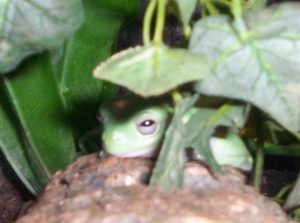
Maintaining good water quality in the paludarium is as important for the health of amphibians as it is for the health of fish. Photo by Kenneth Wingerter.
Even the choice of lid can be of great consequence. Those who intend on introducing climbing herps or insects will need prior assurance that lids are absolutely escape proof. While tight-fitting, solid-structure lids of glass or plastic can help retain humidity, unventilated closures will likely require a framed screen lid to allow for adequate air circulation. Screen tops will probably be the only choice for those that wish to keep basking reptiles, as these lids will not filter out vital UV radiation (as will glass and plastic lids). Additionally, wire mesh is far more resistant than alternative materials to heat damage from certain high-intensity bulbs (such as mercury vapor basking lamps, ceramic infrared-emitting lamps, etc).
Temperature Control
Effective temperature control is essential to the successful long-term operation of a paludarium. Both air and water temperature should be monitored (and, if needed, adjusted) on a regular basis. In some cases, temperature is made to fluctuate in a manner that simulates day/night or seasonal conditions. It may be necessary to apply multiple heating and/or cooling devices-particularly if thermal gradients need to be established between the terrestrial and aquatic sections, or across the terrestrial section itself.
The most simple way of heating the aquatic section is with thermostat-controlled submersible (and preferably shatterproof) aquarium heaters; operating these devices within the reach of amphibians or aquatic reptiles is discouraged, however, as even brief contact can result in burn injuries. Aquarium substrate heating coils may be preferable in that they prevent burns, in addition to benefiting aquatic plant growth. A thermostat-controlled heat pad can be placed underneath, and/or on the wall of, the enclosure. Heat pads are an attractive choice in that they are safe for herps, benefit aquatic plants, and reduce the amount of cords running into the enclosure. Major water cooling will usually require the use of an aquarium chiller. Minor water cooling can be accomplished simply by directing one or more fans over the water surface.
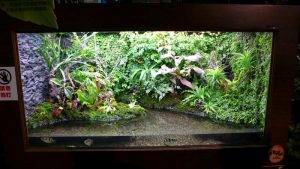
Interesting natural behaviors of some fish species, such as these archerfish (Toxotes jaculatrix), are best elicited-and best observed-in paludaria. Photo by Erich Sia.
The terrestrial section can, if necessary, be similarly cooled with fans. Heating the terrestrial section, on the other hand, can be much more involving. Air has a significantly lower specific latent heat value (i.e., more readily gains/loses thermal energy) than does water; air temperature is consequently far less stable than water temperature. Efforts to control temperature in the terrestrial section can be complicated by fluctuations of airflow or humidity from within, or from without, the enclosure. Further complicating air temperature control is the need (in certain cases) to simultaneously maintain warmer and cooler areas.
Establishing thermal gradients across the terrestrial section facilitates thermoregulation for herps and other exotherms. During daylight hours, locally heated areas-usually encompassing about a third of the volume of the enclosure-can be provided with incandescent spotlights. Any required nocturnal heating can be provided with infrared-emitting ceramic lamps. Side-mounted heat pads can be used to provide either continual or supplemental heat. All heating devices that are to operate on a daily cycle should be individually controlled by automatic timers.

Control of environmental conditions (e.g., air/water temperature, air/water circulation, and air/water quality) should be established within a paludarium long before any livestock is introduced. Photo by Erich Sia.
Water Quality Control
Water filtration can be administered in a number of ways. The chosen method and equipment for this purpose should reflect precedence for the wellbeing of livestock over cost, aesthetic impact, etc.
In certain cases, no filtration (aside from that performed naturally by aquatic flora) will be needed. Modest filtration will be sufficient for a system housing a few small fish and/or amphibians and can be achieved with an air-driven undergravel or sponge filter, whereas a system housing turtles or numerous, larger fish will require the service of a remote canister filter, wet/dry filter, or other similarly capable filter unit. An in-sump filter application might draw from a standing pipe (cut to the desired water depth and capped with a strainer). Most paludaria can be simply and effectively serviced by way of a compact, submersible “turtle tank” filter; these units are specialized for paludarium applications, come in a variety of styles and sizes, and are often equipped with integrated water heaters.
Water Circulation
Ideal configurations of paludarium water movement depend largely upon the type of habitat one wishes to represent. Options for the use of water features (e.g., springs, waterfalls, and so on) are many, each bearing its own unique ecological and aesthetic upshot.

Small, “hillstream” fish species, such as these neon gobies (Stiphodon sp.), are ideally suited to the fast, unidirectional flow of a rocky, lotic ecotope. Photo by Bill Brissette.
In the case of freshwater systems, one of the most basic distinctions to be made is between lotic conditions (i.e., the flowing waters of rivers or streams) and lentic conditions (i.e., the relatively still waters of lakes or ponds). In the former situation, vigorous water movement can be generated by a submersible pump, perhaps directed to the opposite side of the display via PVC pipe as to create the illusion of unidirectional flow; in the latter situation, the sensitive balance between disturbance and stagnation can be maintained with modest air-driven water movement from a bubble wand or undergravel filter.
In the case of marine systems, one might circulate paludarium water via “waves” generated by a small dump bucket or surge device.
Air Circulation
Though its importance is frequently understated, the free movement of air to and from the enclosure is essential to maintaining a healthy paludarium environment. Particularly in a densely stocked system, stale air might produce foul odors, promote the growth of mold and mildew, and/or lead to respiratory illness of reptiles and other creatures.
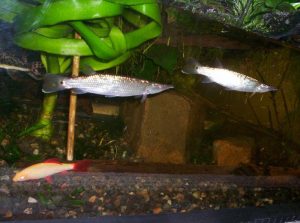
Hujeta gars (Ctenolucius hujeta) in a lentic ecotope. Come feeding time, large ambush predators like these will appreciate the ample space to safely jump and splash at the surface. Photo by Kenneth Wingerter.
In properly ventilated enclosures, fresh, cool air is drawn in as warm air rises, expands, and escapes. At least 10% of the lower one-third back or sides of the enclosure should be opened by perforation or grating. Fully, or nearly, airtight enclosures will most likely need one or more fans. Directing airflow from fans towards the face of the enclosure can improve viewing by reducing condensation on the front panel. Case mount “computer” fans with protective grills can be built directly into the enclosure walls. Small “house” fans can be used, and may be positioned to blow across an open or screened top. Creative use of oscillating house fans can confer aesthetic, as well as environmental, benefits to a display by generating gusts of “wind” that rustle foliage and send small ripples across the water surface.
Humidity and Precipitation
Paludaria are characteristically employed to simulate shoreline (that is, wet) environments. As such, elevated humidity levels are usually acceptable, if not desirable. Ideal ranges depend, of course, upon the particular demands of the plants and animals to be kept. Excessively dry air can quickly dehydrate certain plants and animals, while excessively moist air can contribute to the above described animal health issues. Striking a balance between excessively dry and excessively damp conditions requires a certain degree of control over temperature and air circulation. Humidity levels should be regularly monitored with the use of a high-quality hygrometer.
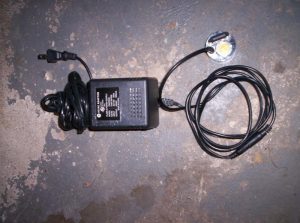
Though an ultrasonic fogger such as this can be placed directly inside the paludarium, placing it instead in a small vessel with clean distilled water will significantly extend the life of its membrane. Photo by Kenneth Wingerter.
One effective (and certainly visually pleasing) way to increase humidity is to apply a fogger. The fog (3-5 micron droplets) they produce is superior to the mist (60-100 micron droplets) produced from hand-held sprayers in that it remains in suspension longer, thereby reducing the threat of unwanted bacterial and fungal growth. There is a wide array of fog generating devices on the market to choose from, though the use of a unit that is specially designed for terraria/paludaria is strongly recommended. Solid-state “ultrasonic foggers” are the usual choice for this application. Most of these are comprised of a water sensor (to detect that the unit is in enough water to function), a small light to indicate that the unit is in operation, and a transducer plate to “break” the water with electrical oscillation frequencies; better units include adjustable output controls and a custom-fitted water bottle.
Certain paludarium ecotopes (e.g., rainforest rivulets) can benefit from simulated precipitation. This effect can be created with a rain chamber. A rain chamber is fairly simple to construct and operate, being little more than perforated pipe that is situated at the top of the enclosure and fed by a small submersible pump. Cycling the system water (and, by extension, nutrients) in this manner can help to integrate the aquatic and terrestrial elements of the display. These and similar devices should be used sparingly as to avoid eroding or water logging the terrestrial section.
Fog and rain simulation is best carried out in short intervals under the control of automatic timers.
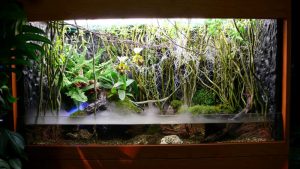
Displays containing epiphytic plants will usually benefit from the elevated humidity produced by a fogger. Photo by Erich Sia.

In addition to creating appealing visual displays, rain chambers aid in the cycling of nutrients by delivering dissolved nitrogenous compounds to terrestrial vegetation. Photo by Bill Brissette.
Lighting
Most styles of fixture that are appropriate for an aquarium or terrarium (PC, T-5, LED, and so on) will be appropriate for a paludarium. Paludarium lighting can be relatively uncomplicated, though its application does present certain unique challenges. The rich diversity of flora and fauna potentially maintained in paludaria suggests that a potentially diverse set of lighting needs might have to be met within a single system. It is therefore incumbent upon the more assiduous paludarist to 1) carefully develop a lighting regime that is well suited to the environment he or she aims to establish, 2) carefully select livestock that is appropriate to the selected lighting regime, and 3) ensure that each specimen will be afforded with an ideal proximity and exposure to the light source.
The quantity and quality of illumination need not be homogeneous throughout the paludarium; indeed, environmental discontinuity (e.g., patches of shade beneath a dense canopy of riparian vegetation) creates microhabitats and thereby increases potential biodiversity. There are a number of cases where it might be advantageous to utilize multiple fixtures, particularly where one must concentrate light of a higher intensity, and/or certain spectrum, in a specific area of the display. Such an arrangement can be applied in a way that conforms to the basic aquatic-terrestrial layout (front-and-back, side-by-side, etc.) of the display.
One such example of this is in the case of systems that include basking reptile species. Basking areas are spotlighted with bulbs that emit both UV-A and UV-B radiation to promote, respectively, proper skin pigment formation and calcium metabolism. Basking lamps are typically concentrated within the “hot spot” (i.e., warmer area) of the paludarium; they should be situated directly overhead, like the sun (basking animals have body shapes and eye positioning that are specialized for efficient, safe, and comfortable sunbathing in this orientation).
Another such example might be found in the use of spotlighting to cast a “beam” of “sunshine” over an area of the aquatic section that contains light-loving, submergent plants. Supplemental lighting of this kind may be directed through the sides, as well as from the top, of the enclosure. This may well be necessary to avoid burning shade-loving emergent or terrestrial plants, which can result from a generalized application of high-intensity (e.g., metal halide) lighting.
Light intensity decreases (due to spreading and scattering) by the square of the distance from the lighting source. Hence, moving a bulb a mere couple of inches away from the water surface can decrease its intensity by a factor of four; raising a lighting fixture high above the water, as with a paludarium, will significantly limit the amount of usable light that can be intercepted by the very same plants and animals it is intended for. The presence of scattering constituents (e.g., fog) further degrades light transmission. Reflection off of the paludarium walls and the water surface can alter the intensity and even character of light. Accounting for all of these-and yet many other, important factors-can be exceedingly difficult. Arguably, there are few places where a PAR meter can simplify light intensity calculations more than in a paludarium.
Conclusion
By its very nature, paludarium keeping offers hobbyists an enormous selection of plants and animals-with rather sundry husbandry requirements-to cultivate and display. Accordingly, the prospective paludarist must invest a considerable amount of thought in the planning of these systems. At present, paludarium design demands a considerable amount of both circumspection and resourcefulness, being as the available enclosures and equipment are most frequently designed for aquaria or terraria. As interest (i.e., commercial demand) in this art grows, however, one can only expect to see measurable gains in the development of paludarium-specific products and services. A comprehensive knowledge of paludarium construction/operation will thusly be of increasing value not only to hobbyists, but to retailers and manufacturers, for some time to come.
Sources
- Alderton, David. Firefly Encyclopedia of the Vivarium: Keeping Amphibians, Reptiles, and Insects, Spiders, and Other Invertebrates in Terraria, Aquaterraria, and Aquaria. Buffalo, NY: Firefly Books Ltd., 2007.
- Buruchovitz, David E. Mini-Aquariums: A Guide to Successful Nano Aquariums. neptune City, NJ: TFH Publications, 2008.
- Alderton, David. The Exotic Pet Survival Manual. Hauppauge, NY: Barron’s Educational Series, Inc., 1997.
- Jes, Harald. The Terrarium. Hauppauge, NY: Barron’s Educational Series, Inc., 2000.
- Bartlett, Patricia P., Billy Griswold, and R.D. Bartlett. Reptiles, Amphibians, and Invertebrates: An Identification and Care Guide. Hauppauge, NY: Barron’s Educational Series, Inc., 2001.
- Bartlett, R. D. The 25 Best Reptile and Amphibian Pets. Hauppauge, NY: Barron’s Educational Series, Inc., 2006.
- http://www.paludarium.net
- http://www.aquariacentral.com/forums/showthread.php?t=183835
- http://www.aquariacentral.com/forums/showthread.php?t=221495
- http://en.wikipedia.org/wiki/Paludarium




0 Comments